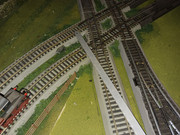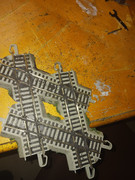Anyways, a nagging project has been to alter the flangeways on this Bachmann EZ Track (made especially for those of us who cannot draw a crooked line) to adapt it to some of this older Triang and Hornby stuff that I like to pull off the shelf from time to time. It runs quite smoothly over the point's flangeways with no issue, but these oldsters seem to grab upon the cross over flangeways (there are eight. I had a bit of an infatuation with crossings).
So, whatever is causing trouble, it would not seem to be the gauge, but perhaps the guardrails. Thus, my first effort was to see about filing them down, and this helped, but not enough for smooth running. After hours spent with an emory board, I think it is reasonable to try to remove them entirely as these guardrails, designed for a North American contour of 1/87th wheel than anything of older British. The hacksaw blade, pictured, will seem to be another Homeric effort, so will get a cut off wheel and see if I can make quick work of the offending guardrails.


